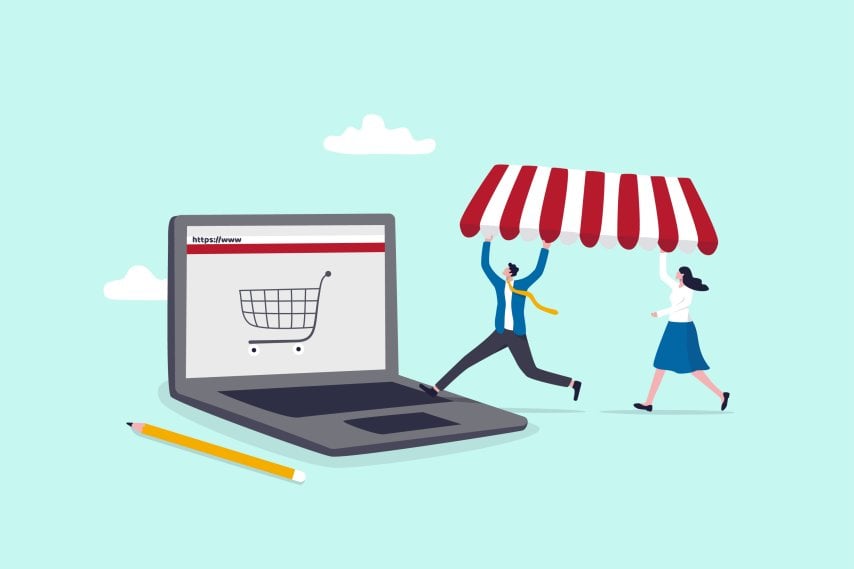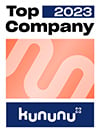Direct-to-consumer business: what you need to know about it

You've probably heard of D2C or direct-to-consumer. This is a type of sale that is not so new. Manufacturers sell directly to the end consumer, without any intermediaries. This type of sale used to be common until it was replaced by B2C sales. In the meantime, however, direct sales from the manufacturer to the end customer are on the upswing again. Read on to find out why this is the case, what you need to know about D2C and why you should consider this sales option as a manufacturer. If you want to take your e-commerce business to the next level, we'll be happy to help and advise you.
Reading time 5 min
- What does D2C actually stand for? Here's the definition.
- Why you should use D2C for yourself: The pros and cons
- Understand your customers better with direct-to-consumer
- You have control
- More margin for your business
- Increase brand awareness
- Try out new products
- How you can use D2C
- Popular sales channels
- Marketing measures
- Is direct-to-consumer also suitable for you?
- Our D2C tips
- FAQ: Questions and answers
What is D2C?
D2C stands for Direct-to-Consumer and describes the sale from the manufacturer or producer directly to the end consumer. In contrast to widespread B2C (business-to-consumer) sales, there is no intermediary between the producer and the consumer. For the manufacturer, D2C sales have some advantages such as higher profits and direct customer contact. Of course, the business model also has some disadvantages. We will discuss the advantages and disadvantages later.
D2C sales are nothing new. In the past, it was common for manufacturers to sell their goods directly to the end consumer. With mass production and a good infrastructure, D2C sales gave way to B2C sales. Goods were and still are bought in large quantities by companies such as supermarket and department store chains as well as large marketplaces and online retailers and sold to end consumers. D2C sales are now experiencing an upswing again. Find out below whether D2C is also suitable for you and how you can benefit from it.
Reasons for D2C sales and advantages and disadvantages
Now let's take a look at why D2C sales could be interesting for you as a manufacturer and what the advantages and disadvantages are. If you rely on direct-to-consumer, this does not mean that you cannot also sell to intermediaries. Some manufacturers rely on two types of sales in order to get their products to as many customers as possible. We have briefly listed the advantages and disadvantages to give you an overview. For a detailed description, you can read the following headings and the corresponding paragraphs.
Advantages and disadvantages in a brief overview:
| Advantages | Disadvantages |
|---|---|
Better understanding of your customers
As a rule, you have little to do with your customers outside of the D2C model. This also means that you rarely receive direct feedback from the users of your products. However, this is sometimes important in order to identify what needs to be improved or added to the product range. In principle, direct customer contact gives you inspiration for new products and allows you to get to know the likes and dislikes of your target group.
Another plus point is that you can receive praise for your products directly via social networks or email contact. This may not be directly profitable in a financial sense, but it is still nice and motivating. Being close to your customers can also generate a certain brand loyalty if the buying experience is positive.
Full control
When you sell to the end consumer yourself, you have full control over all decisions. You choose how your products are packaged, how they are shipped, how you incorporate sustainability into your store and which marketing strategies you pursue.
Less loss of profit by selling to intermediaries
If you sell to middlemen, they also want to earn money from your product. For this reason, you cannot usually sell your products at the same price as to the end customer. The middlemen earn money from your product idea, the development of the products, etc. If you opt for D2C sales, you alone make a profit. This also ensures higher profit margins on your side. Or you have the option of selling the product to end customers at a lower price. This can also expand the target group, as the item becomes affordable for more people.
Brand awareness
The topic of brand awareness is quite complex, as it is not that easy to establish yourself as a brand on the Internet and become known to your target group. Having your own online store with your products could initially mean that hardly any visitors find their way to your store. You need to take the time to make your online store known through selected marketing strategies. This takes time. But once you have done this, it will pay off. To start with, you can of course also choose a marketplace to attract your first customers. This way, your products will be found more quickly and once you have built up a certain circle of people who know your products, more visitors will come to your own online store. Independence from marketplaces is important in order to save on taxes and marketplace costs.
New innovations
It is usually difficult to launch new products on the market if you are dependent on the intermediary buying them. In general, you probably don't just sell to one retailer, but to several. It's not that easy to do justice to their ideas and product range plans. However, if you opt for D2C, you can quickly find out for yourself whether your customers like a product idea or not. Thanks to social media, it is even possible to conduct a survey of your target group beforehand to test how your idea is received or what wishes customers may even have themselves. If a product is not yet so popular with the target group, changes and improvements can be made in a joint effort.
How can you sell direct-to-consumer?
If you are a manufacturer of products, you have probably sold to bulk buyers in the past. But now you want to reach end customers yourself. In principle, you have two options: Over-the-counter retail or online retail or e-commerce. But even in e-commerce, there is not just one way. We will briefly introduce you to the individual sales channels.
The most popular sales channels
Of course, the internet is the easiest way to sell products to the end consumer. You can either set up your own online store with Shopware and Shopify, for example, or you can choose to sell via a marketplace such as Amazon, Etsy or eBay. With marketplaces, you can simply register as a retailer and create items. You don't have to actively attract customers to your site as they are already on the marketplaces. It's much more about offering attractive products that are currently of interest. Present them attractively on the platform and ensure good quality. If you have your own online store, you will most likely have to put more work into marketing, but this is definitely interesting and gives you more independence.
No matter what you decide, both ways have their advantages and disadvantages. Having your own online store may be a little expensive at the beginning, but it can be worth it in the long run, as marketplaces always charge a certain fee for sales. The more successful you sell, the higher the costs for you. In your online store, your profits stay with you. We will be happy to advise you on your options for online trading and help you find the right sales platform for your D2C project.
Another option is to open a store. However, we consider this option to be much more difficult. You first have to find the right location, preferably where your target group is. But that's not so easy. Reaching many people in brick-and-mortar stores is particularly difficult for newcomers. If you have not yet sold directly to end customers, we recommend that you try online first. This will allow you to gain your first experience much more quickly.
D2C marketing
As with almost every form of sales, there are various marketing strategies and channels for direct-to-consumer. For example, you can use social media marketing, search engine marketing and email marketing to promote D2C sales.
You can reach your potential customers directly via social networks. This does not necessarily require you to invest financial resources. A modern company account with content that interests your target group is often enough. Of course, you can also create advertisements that are broadcast directly to a group of people defined by you. This also gives you the opportunity to quickly receive feedback on your products and implement it directly in a success-oriented manner.
Another option for your marketing is search engine optimization (SEO), especially for your own online store. You can use SEO virtually free of charge by optimizing texts on your website or in your online store for the search engine, usually Google. To do this, you use certain keywords that you incorporate into your store on a regular basis. Of course, many other aspects are required in order to be visible in the search results. This may not cost anything at first, but it is time-consuming.
Is D2C right for you?
Now it's time to find out whether the D2C model is also suitable for you as a manufacturer. If you decide to sell in your own online store or via a sales platform, you should at least be interested in the online world and have a certain level of understanding. And of course, the motto "the customer is king" should be your top priority, even if you want to sell in a brick-and-mortar store. Maintaining customer relationships is essential in order to be well received and remembered by end consumers. Even if you find yourself in the right, it's not about insisting on it, but about offering your customers the best possible experience with your products and your brand. This also requires you to engage with your target group and understand their needs. To help you get started in D2C business, we have put together a few interesting tips for you in the following paragraph.
D2C tips for a good start
A certain amount of preparation is a must for a successful start to your new business model. Simply follow our tips and you'll be one step closer to success.
1. a specific target group
In order to reach your desired customers, you need to define your target group. To do this, you should be as specific as possible in order to know their needs and wishes. Addressing your customers directly and being able to solve their problems will help you gain a foothold in the D2C business.
2. calculate your profit margin
Yes, your margin is higher when you reach your customers directly. But that doesn't mean you should lower your prices to attract your target audience to your store. If you continue to sell to retailers and wholesalers, you will drive them away. On the other hand, you have already established that the price for your products is perfectly fine, because it also works for other retailers. Benefit from the higher margin and use it to make your company even more attractive: By expanding your product range, opening up additional sales channels, innovative marketing campaigns and much more.
3. don't do everything yourself
In the beginning, you probably want to keep your costs as low as possible. After all, you don't yet know whether your plan will work out and your D2C business will be a success. However, you shouldn't do everything yourself. Especially not if it takes a lot of time to familiarize yourself with the topic. Seek support from experts who know what they are doing. Either look for a partner who offers relevant services such as social media marketing or the creation of an online store, or hire other employees who are already familiar with the field.
4. think carefully about your marketing strategy
To prevent your marketing expenditure from skyrocketing, you should think about which strategy you want to use. In particular, you should think about where your target group is most likely to be found. Perhaps you have already been able to collect some data and can use it to tailor your marketing campaign accordingly. Personalize emails and other advertising measures as much as possible. You shouldn't leave out existing customers either, as they are usually quicker to pick up and convince.
FAQ - further questions and answers about the D2C business model
Now let's take a look at the frequently asked questions about direct-to-consumer business. If you have any other questions, you can contact our experts at any time.
-
What distinguishes D2C from other business models?
D2C online retail involves the sale of products from a manufacturer to the end consumer. The middleman or bulk buyer is left out of the equation here. Most manufacturers tend to sell large quantities to other companies that specialize in B2C sales. The manufacturer, on the other hand, tends to operate B2B e-commerce. With the not-so-new method of direct-to-consumer sales, manufacturers are able to sell smaller quantities and offer the end consumer attractive prices, as there is no need for a middleman to earn money from the sale.
-
Why is D2C used?
D2C is often used by manufacturers to find out more about their target group. The focus is often not on the sale itself. The collection of important data and the resulting insights are what make direct-to-consumer sales so appealing. For example, you can find out what your customers are looking for, which social media channels they use, which products they like and much more.
-
What challenges do you face with D2C e-commerce?
Of course, you also face a few hurdles in D2C online retail. The main one is that you have to compete with established retailers and chains. The experience of existing retailers in particular will make it difficult for you to stand out from them. Analyze your competition and find out what you can do better. It usually helps to tell a personal story, respond to your customers and take creative approaches that suit your target group. The reach will not be high at the beginning, but over time you will have the opportunity to build up a customer base. Another challenge is to interpret the collected data correctly. Only when you recognize what is behind the numbers and data can you apply them in a meaningful way and make use of them. If you need help with the data management of your e-commerce business, please contact us. At EXWE, we have years of experience in the field of e-commerce and will work with you to take your online business to the next level
Was ist dein Projekt? Wenn du uns darüber erzählen möchtest, rufen wir dich zurück!

Hello, my name is Meike. I take care of the EXWE back office and am responsible for our social media channels. All of our articles are meant to make your life easier and help you make decisions. Nevertheless, it can happen that something remains unclear, so: If you have questions about this article you can easily reach me at +49 231 93149827.
Learn how to create a successful Shopify store step by step and launch your own online shop with confidence. Our comprehensive guide walks you through the process, empowering you to build a thriving e-commerce business from scratch.
The PIM guide for your Shopware store ✓ PIM system definition ✓ Functions ✓ Recommendations for Shopware extensions integration ✓ Individual PIM development
Which programming languages can be used for the backend? We introduce you to ten backend languages and explain what you can use them for.





